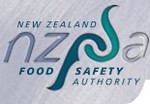Test results from Japanese food imports
MAF has been closely monitoring the situation in Japan following the 11 March earthquake to ensure food imports from Japan to New Zealand are safe and suitable.
The National Radiation Laboratory is performing targeted testing to examine foods from affected prefectures in Japan for radioactivity.
Testing has been undertaken to ensure radionuclide levels are under international safe levels.
Test results
As at 11 July, 17 products from selected Japanese prefectures have been tested. These have been deemed safe for consumption and cleared for sale.
The foods and prefectures that have been targeted are as follows:
1. Foods from the prefectures of Fukushima, Miyagi, Gunma, Ibaraki, Chiba or Tochigi. These prefectures are the most likely to have been affected by radionuclide contamination.
Foods of interest include:
Milk and other products containing dairy
Meat and offal of mammals and poultry
Seafood and fish – dried, fresh and frozen
Fresh vegetables and fruit – dried, fresh and frozen
Seaweed – dried, fresh and frozen
Dried mushrooms (where collected in the wild)
Tea
Rice and cereals
Soy bean and related products eg soy bean paste, bean curd and miso
Pickled ginger
Wasabi
2. Tea from the Japanese prefectures of Saitama, Tokyo, Yamanashi, Shizuoka and Kanagawa. Tea from these prefectures may have been affected by windborne radionuclide contamination.
3. Foods from the Japanese prefectures of Niigata, Yamagata and Nagano.
Foods of interest include fresh leafy greens. Foods from these prefectures have not returned any results greater than the Codex limits for more than two months.
Test results are assessed against the following international (Codex Alimentarius) levels:
total Cs-137 and Cs-134 must not be more than 1000 Bq/kg (Becquerel per kilogram)
I-131 must not be more than 100 Bq/kg.
The results found to date are no cause for concern. All food products tested were found to be well below actionable levels for radiation. The radioactivity levels found are indistinguishable from the naturally occurring background levels we would expect to find in food and from the machinery used to test the foods.
The levels reported are below the limit of detection and are not able to be broken down to levels from the food or machinery. Typically background radioactivity levels are below 2 Bq/kg.
Next steps
Japan is continuing to impose controls on the sale and export of potentially contaminated products from affected prefectures. MAF will continue testing, collecting and assessing information from Japanese officials and international authorities.
For more information on the presence of radiation in everyday life, go to http://www.world-nuclear.org/education/ral.htm
For more information on the safety of food from Japan, go to
http://www.foodstandards.gov.au/scienceandeducation/factsheets/
factsheets2011/safetyoffoodfromjapa5110.cfm
For more information on Japan nuclear concerns please go to
http://www.who.int/hac/crises/jpn/en/index.html
